#dietrich smith
Explore tagged Tumblr posts
Photo

Title: Destroyer
Author: Victor LaValle, Dietrich Smith
Series or standalone: standalone
Publication year: 2018
Genres: fiction, graphic novel, horror, science fiction, comics, retelling, fantasy
Blurb: Many years ago, Frankenstein’s monster beseeched his creator for love and companionship...but in 2017, the monster has long discarded any notions of peace or inclusion. He has become the Destroyer, his only goal to eliminate the scourge of humanity from the planet. He initially finds a willing partner towards this goal in Dr. Baker, a descendant of the Frankenstein family who has lost her teenage son after an encounter with the police. While scientists Percy and Byron initially believe they’re brought to protect Dr. Baker from the monster, they soon realise they may have to protect the world from the monster and Dr. Baker’s wrath.
#destroyer#victor lavalle#dietrich smith#standalone#2018#fiction#graphic novel#horror#science fiction#comics#retelling#fantasy
8 notes
·
View notes
Photo

22 notes
·
View notes
Text

What If...? Vol 1 93 / Published: November 10, 1996 / Artist: Dietrich Smith
0 notes
Text
The way Erwin puts his arm around Hange to welcome her :')

#spoilers#snk spoilers#aot spoilers#hange zoe#erwin smith#mike zacharias#moblit berner#nanaba#ian dietrich#lynn
42 notes
·
View notes
Text
the queer ladies have finally started making some noise, but it's not the booming bass and unc unc unc of party music, which I am grateful for, because that is music you can't tune out because you feel it in your chest.
6 notes
·
View notes
Text

March 1976. Looking at this cluttered, generic, frankly ugly cover (by Gil Kane, inked by Frank Giacoia), you would not realize that it disguises one of the best comics Marvel published in the 1970s. Even discounting the awful cover, the fact that this IS one of the best comics of the 1970s is preposterous: MASTER OF KUNG FU was an attempt to simultaneously cash in on the martial arts craze and also fulfill an earlier commitment to produce a licensed comic based on Sax Rohmer's Fu Manchu (yes, THAT Fu Manchu), mixing Alan Watts Orientalist philosophizing, over-the-top wuxia fight scenes, and Roger Moore-era James Bond plots. And yet...

The text above the main title is a brief summation of the series; all Marvel comics of the period had this. It reads: "Call me Shang-Chi, as my father did, when he raised me and molded my mind and my body in the vacuum of his Honan, China retreat. I learned many things from my father. Since then, I have learned that my father is Dr. Fu Manchu, the most insidiously evil man on earth...and that to honor him would bring nothing but dishonor to the spirit of my name."


From here, the story pursues some of Moench's recurring themes — divided loyalties and psychosexual drama (see also: kinky martial arts weirdos hurting each other's feelings) — while Gulacy continues to produce exceptionally compelling layouts, slightly dodgy anatomy, and unauthorized celebrity caricatures. Smith's counter-agent Juliette, you see, is a nightclub singer who happens to look very much like Marlene Dietrich circa 1932:

I won't spoil what happens next, except that it will not surprise you to learn that there is a big fight and a lot of heavy drama, concluded in the following issue.
Oh, and in case you were worried about the Siamese kitty from the beginning of the story:

#comics#master of kung fu#shang chi#gil kane#doug moench#paul gulacy#dan adkins#marlene dietrich#sax rohmer#fu manchu#denis nayland smith
7 notes
·
View notes
Photo

#Marlene Dietrich#charles boyer#movie poster#basil rathbone#c aubrey smith#tilly losch#joseph schildkraut#john carradine#alan marshal#david o selznick#technicolor#film#movie posters#films#poster
16 notes
·
View notes
Text


Marlene and C. Aubrey Smith in The garden of Allah.
#c. aubrey smith#marlene dietrich#richard bolelawski#the garden of allah#domini enfilden#le jardin d'allah
1 note
·
View note
Text

Pictured: Suzy Dietrich, part of one of two all-female teams during the 1966 edition of the race
Always There, Women in Motorsport: Women at the 24 Hours of Daytona
Women's history in motorsport is rich, and that has always been the case. This year we will have seven women competing in the race, but back in 1966, when it was run as a 24 Hour race for the first time, we already had five women competing in the race.
The 24 Hours of Daytona was first run in 1966 but its history goes back to 1962 when it was first run as a 3 Hours race counting towards the FIA’s International Championship for GT Manufacturers (Later known as the World Sportscar Championship). 1963 would also see a 3H race. In 1964 and 65 a 2000 Km race would be held, which was about half the length of the 24H of Le Mans at that time. In 1966 the race turned into a 24 Hour race and has ran as such since with two exceptions*
*In 1972 the race was shortened to a 6 Hour race as the FIA feared the reliability of the 3.0 liter cars and in 1974 the race was not run due to the energy crisis.
In 1966 the 24 Hours of Le Mans had already run over 30 editions and with success for women at that. In 1930 Marguerite Mareuse and Odette Siko would become the first women to compete in the race, finishing 2nd in class and in 1932 Siko would even go on to win her class. The 1930s would prove to be successful for women as in 1935 a record of 10 women would compete at Le Mans. In 1957 women were prohibited from competing at Le Mans and this ban would only be lifted in 1971.
During the period of this ban, the first 24 Hours of Daytona would be run which saw two all female teams compete. Rosemary Smith and Sierra ‘Smokey’ Drolet finished 30th overall and sixth in their class in a Sunbeam Alpine. While Janet Guthrie, Donna Mae Mims and Suzy Dietrich finished 32nd overall and won their class in a Sunbeam Alpine.
Clipping from The Boston Globe · Sunday, February 13, 1966 Mentioning these performances

Sunbeam Alpine Driven by Donna Mae Mims, Janet Guthrie, and Suzy Dietrich at the Daytona 24 Hour Continental Race, February 1966 (Source: thehenryford.org)
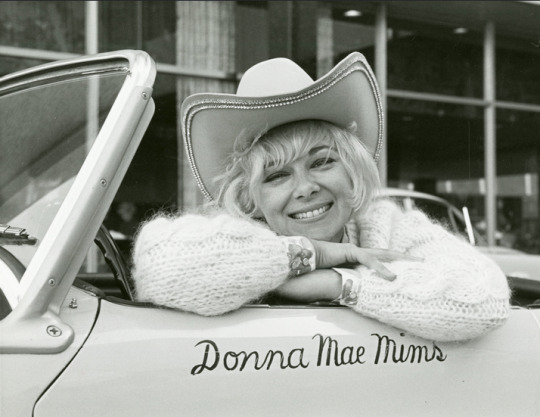
Donna Mae Mims, also known as the "Pink Lady" was the first woman to win a Sports Car Club of America national championship. Also one of the first women to compete in the 24H of Daytona (Source: Sports Car Club of America Archive)
Women would continue to compete at the race with another all-female team competing in 1967 consisting of Janet Guthrie, Sierra ‘Smokey’ Drolet and Anita Taylor driving a Ford Mustang. They finished fifth in class and 20th overall. Smokey would go on to win her class in 1969 driving a Corvette with John Tremblay, Vince Gimondo and John Belperche finishing sixteenth overall. That same year she would finish the 12 Hours of Sebring second in class together with Rosemary Smith. In 1970 Smokey would finish 25th overall while Donna Mae Mims competed but failed to finish
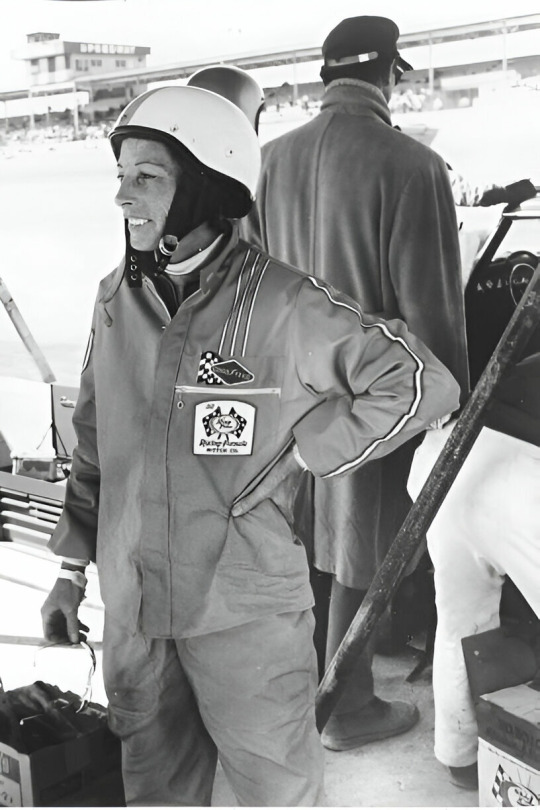
February 5, 1967: Sierra “Smokey” Drolet awaits her turn behind the wheel of the Ring Free-sponsored Ford Mustang she co-drove with Anita Taylor and Janet Guthrie during the 24 Hours of Daytona. (Photo by ISC Images & Archives via Getty Images)
In 1977 another female team took the start Christine Beckers and Lella Lombardi would share an Inaltéra GTP but unfortunately they did not make it to the finish. In 1980 Kathy Rude would drive in the 24 Hours of Daytona for the first time, finishing eight in the GTO Class together with her teammates. That same year Anne-Charlotte Verney would finish 9th overall and fifth in the GTX class while Lyn St. James finished 17th overall and Christine Beckers would finish 47th overall.
In 1981 Rude would finish seventh overall and third in the GTU class with her teammates Lee Mueller and Philippe Martin in a Mazda RX-7, Gaile Engle (36th overall) and Vicki Smith (56th overall) would also compete. The following year she would team up again with Lee Mueller, and she achieved a class win and sixth place overall with Allan Moffat as third driver. Vicki Smith also returned with a 25th place overall and Desiré Wilson would finish 45th overall.
In 1983 Rude would return to the race, now with an all-female team. Rude, Deborah Gregg, and Bonnie Henn would finish thirteenth overall and sixth in class in their Porsche 924. Smith and St. James also competed finishing 35th and 44th overall respectively. Kathy Rude would unfortunately suffer a huge crash at Brainerd that same year which left her in a coma for several weeks. She recovered but it meant she never got the chance to compete in IndyCar where she had arranged a seat for the 1984 season. The following years also saw women compete but without much success.
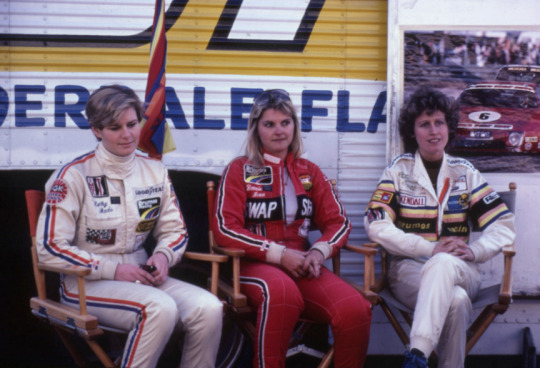
Kathy Rude, Bonnie Henn, Deborah Gregg Photo: Robert Fischer
In 1987 Lyn St. James finished 7th overall and first in the GTO Class, together with her teammates Tom Gloy, Bill Elliott, and Scott Pruett. Deborah Greg would finish 9th overall and 3rd in the GTO class while Linda Ludemann finished 16th overall.

Drivers Bill Elliott, Lyn St. James and Tom Gloy in victory lane following the SunBank 24 at Daytona International Speedway. (Photo by ISC Images & Archives via Getty Images)
Ludemann and James would continue to compete in the race in the coming years but it wasn’t until 1990 that there was success again. James would finish fifth overall and win the GTO class together with her teammates Robby Gordon and Calvin Fish in a Mercury Cougar. Ludemann would finish 17th overall.
Tomiko Yoshiwaka and Desiré Wilson would finish 47th overall in 1993. 1994 would see the return of an all-female team when Linda Pobst, Kat Teasdale, Margy Eatwell, Tami Rai Busby, and Leigh O’Brien finished 47th overall. That same year Lilian Bryner (15th overall), Kat Teasdale (17th overall) and Tammy Jo Kirk (34th overall) would also compete.

Tomiko Yoshikawa at Daytona in 1993
1995 saw another female class win when Lilian Bryer finished fifth overall with her teammates Enzo Calderari, Renato Mastropietro & Ulli Richter. They won the GTS-2 Class in their Porsche 911. The following year that same line-up would win their class again while they finished fourth overall. A little under 10 years later, in 2004, Lilian Bryner made history when she won the 24H of Spa overall.
In 1997 Claudia Hürtgen would finish 4th overall and first in the GTS-2 class with her teammates Ralf Kelleners, Patrice Goueslard, and André Ahrlé in their Porsche 911 GT2. This is the last female class win to date. Throughout the late 90s into the early 2000s women continued to compete in the race. The biggest success came for Milka Duno when she finished 2nd overall in 2007 with a Riley mK XI together with Dario Franchitti, Marino Franchitti, and Kevin McGarrity. This remains the highest overall finish of a female driver to date.
In 2019 an all-female entry returned when Simona de Silvestro, Katherine Legge, Bia Figueiredo, and Christina Nielsen finished 32nd overall and 12th in the GTD class in an Acura NSX GT3. The following year Tatiana Calderon, Rahel Frey, Legge and Nielsen competed in a Lamborghini Huracan but failed to finish.

Simona de Silvestro, Katherine Legge, Christina Nielsen, and Bia Figueiredo in 2019
From 2013 up until the race this year, at least a single woman has competed. With a record of entries coming in 2024 when nine women competed. This year 7 women will compete in the race with Karen Gaillard making her debut in the race.
#this was meant to be short#it passed 1k so not so short anymore#sorry for the half assed ending almost skipping over 2 decades but i feel like people know way more about recent stuff so post turn of#the century so i aimed at most of the things before that#rolex 24#imsa#24h of daytona#24h daytona#women in motorsport#*history series#i have an incredible headache so pls ignore any grammatical errors while reading
89 notes
·
View notes
Text
My Super Gay/Queer Reading List

The Long Run by James Acker
Simon vs. the Homo Sapiens Agenda by Becky Albertalli
Another Dimension of Us by Mike Albo
Wonders of the Invisible World by Christopher Barzak
Alan Cole Is Not a Coward by Eric Bell
Alan Cole Doesn’t Dance by Eric Bell
The Darkest Part of the Forest by Holly Black
In Other Lands by Sarah Rees Brennan
Felix Yz by Lisa Bunker
Last Bus to Everland by Sophie Cameron
Dragging Mason County by Curtis Campbell
The House of Impossible Beauties by Joseph Cassara
Peter Darling by Austin Chant
Carry the Ocean by Heidi Cullinan
The Love Interest by Cale Dietrich
Half Bad by Sally Green
Half Wild by Sally Green
Half Lost by Sally Green
Heartbreak Boys by Simon James Green
Gay Club by Simon James Green
You’re the One That I Want by Simon James Green
We Contain Multitudes by Sarah Henstra
Totally Joe by James Howe
After School Activities by Dirk Hunter
At the Edge of the Universe by Shaun David Hutchinson
The Past and Other Things That Should Stay Buried by Shaun David Hutchinson
We Are the Ants by Shaun David Hutchinson
The Five Stages of Andrew Brawley by Shaun David Hutchinson
A Complicated Love Story Set in Space by Shaun David Hutchinson
The Boy Who Couldn’t Fly Straight by Jeff Jacobson
Haffling by Caleb James
The Lightning-Struck Heart by T.J. Klune
A Destiny of Dragons by T.J. Klune
The Consumption of Magic by T.J. Klune
A Wish Upon the Stars by T.J. Klune
The Extraordinaries by T.J. Klune
Flash Fire by T.J. Klune
Heat Wave by T.J. Klune
The House in the Cerulean Sea by T.J. Klune
Openly Straight by Bill Konigsberg
The Bridge by Bill Konigsberg
Destination Unknown by Bill Konigsberg
The Gentleman’s Guide to Vice and Virtue by Mackenzi Lee
Two Boys Kissing by David Levithan
Every Day by David Levithan
Boy Meets Boy by David Levithan
Ryan and Avery by David Levithan
How to Repair a Mechanical Heart by J.C. Lillis
Take a Bow, Noah Mitchell by Tobias Madden
When Ryan Came Back by Devon McCormack
Red, White & Royal Blue by Casey McQuiston
Fraternity by Andy Mientus
The Song of Achilles by Madeline Miller
The Art of Starving by Sam J. Miller
Hero by Perry Moore
I’ll Give You the Sun by Jandy Nelson
More Than This by Patrick Ness
Junior Hero Blues by J.K. Pendragon
The City Beautiful by Aden Polydoros
When Everything Feels Like the Movies by Raziel Reid
Kens by Raziel Reid
Emmett by Lev A.C. Rosen
Jack of Hearts by Lev A.C. Rosen
Camp by Lev A.C. Rosen
Carry On by Rainbow Rowell
Wayward Son by Rainbow Rowell
Rainbow Boys by Alex Sanchez
Rainbow High by Alex Sanchez
Rainbow Road by Alex Sanchez
So Hard to Say by Alex Sanchez
The 99 Boyfriends of Micah Summers by Adam Sass
The Darkness Outside Us by Eliot Schrefer
All Kinds of Other by James Sie
They Both Die at the End by Adam Silvera
History Is All You Left Me by Adam Silvera
More Happy Than Not by Adam Silvera
Grasshopper Jungle by Andrew Smith
Freak Show by James St. James
Ray of Sunlight by Brynn Stein
The Dangerous Art of Blending In by Angelo Surmelis
366 Days by Kiyoshi Tanaka
The Language of Seabirds by Will Taylor
Cemetery Boys by Aiden Thomas
Wild and Crooked by Leah Thomas
Because You’ll Never Meet Me by Leah Thomas
Spin Me Right Round by David Valdes
Always the Almost by Edward Underhill
Hell Followed With Us by Andrew Joseph White
Tumblr got rid of yellow so I couldn't do pride colors, sorry!
If you want help picking something out just send me an ask with what kind of thing you're looking for and I'll select something for you, and if you end up reading something because you saw this list, please let me know
#books#reading#book list#gay books#queer books#queer lit#red white and royal blue#love simon#Carry On
325 notes
·
View notes
Text

The Best Album Cover Shoots – in pictures
From the Beatles crossing a zebra to a naked Prince, via Grace Jones attempting the anatomically impossible and Led Zeppelin’s New York tenements, these cover designs became as famous as the music they enclosed 🎶🎵👏
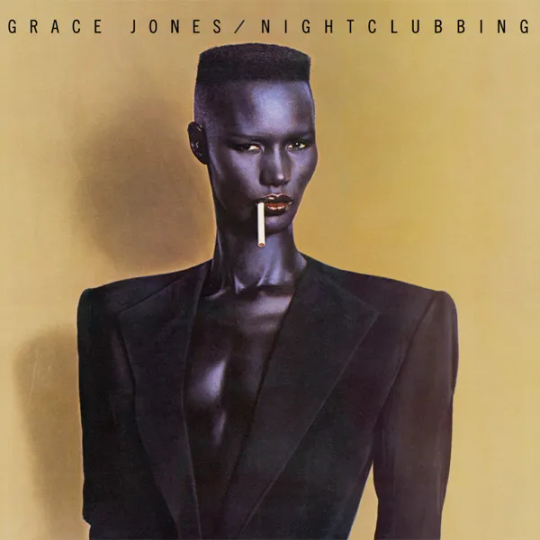
Grace Jones – Nightclubbing, Island Records, 1981, by Jean-Paul Goude
Nightclubbing's iconic artwork is a 1981 painted photograph titled Blue-Black in Black on Brown, created in New York by Goude. This was the singular image that accompanied the original LP, as it "was concealed in a plain, black inner sleeve, no lyrics and with no photo on the back cover." Composed by right angles, the photograph shows Jones cut to waist, bare chested, and dressed in an Armani man's wide shouldered suit, with an unlit cigarette aiming downward from her lip. She is shot with her signature flat top haircut and her chest bones showing; her dark skin confers upon the image a violet, blue-black colour. The image is noted for its androgyny, with Jones not only "[unpicking] some of the boundaries of unconventionality, but [choosing] to confuse such boundaries." Rick Poynor writes: "Goude admired Jones for her mixture of beauty and threat, and the Nightclubbing portrait expresses this duality with absolute composure and no false histrionics." Piers Martin of Uncut felt the cover was "arresting", and wrote: "the indigo mood, cool gaze and cigarette suggested Marlene Dietrich, the gender-bending a touch of Bowie."

Prince – Lovesexy, Paisley Park, 1988, by Jean-Baptiste Mondino (design by Laura LiPuma)
The artwork of Lovesexy sparked as much interest as did the music. Mimicking The Birth of Venus by Botticelli, the cover shows Prince reclined naked with a lily stamen suggestively positioned above his groin. It is an image that captures the LP’s essence of spirituality perfectly. Prince had even denied Warner’s management sight of the cover prior to the album’s retail release. The image was deemed far too risqué for 1988 and prompted many retailers to conceal the artwork under black plastic wrapping (Wal-Mart refusing to stock it at all) or keeping it behind the counter, deeming it too provocative to display in store. It is likely this hindered sales of the album in the more conservative leaning US. The shot is the work of fashion photographer Jean-Baptiste Mondino, Prince’s first choice to direct Under The Cherry Moon but was unavailable. Mondino would instead direct the video Mia Bocca for Jill Jones which led to doing likewise with I Wish U Heaven for Prince. He would also shoot promos for Neneh Cherry (Manchild) and Madonna’s Justify My Love. During a breakfast in LA, Prince asked Mondino if he would shoot the album’s cover. The image was captured in LA, with the lilies and stamen added at Mondino’s studio back in Paris using Paint Box software, a forerunner to Photoshop.
Mondino’s cover is the sole promotional image shot for the album – its back cover and inner sleeves feature the tracklisting and lyrics hand drawn by Margo Chase. With no alternative shots available and keeping with the theme of nakedness, the singles Alphabet St. and Glam Slam were issued without artwork, their transparent sleeves labelled with a sticker. In April 2022 Lovesexy was exhibited at The Photographers’ Gallery in London staged in celebration of the art of iconic album designs.

Boz Scaggs – Middle Man, Columbia, 1980, by Guy Bourdin
Middle Man is the ninth studio album by Boz Scaggs, released by Columbia Records in 1980. Scaggs hired members of the band Toto as session musicians (as he did for Down Two Then Left and Silk Degrees) and shared songwriting credits with them, returning to the commercial, soul-influenced rock of the latter. It would take him eight years to release his following album Other Roads, again retaining the personnel of the three preceding it.
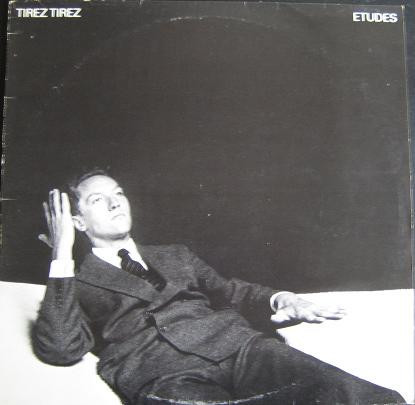
Tirez Tirez – Etudes, Aura, 1980, by Brian Griffin (design by Bill Smith)
Brian Griffin: ‘This photograph was taken in my studio/bedroom at Elsynge Road in Wandsworth [south London] using my bed. The model is Martin Cropper, who I used in my work at the time. It was originally taken for my book Brian Griffin Copyright 1978 and later purchased for the cover by Aaron Sixx of Aura records for Tirez Tirez’.
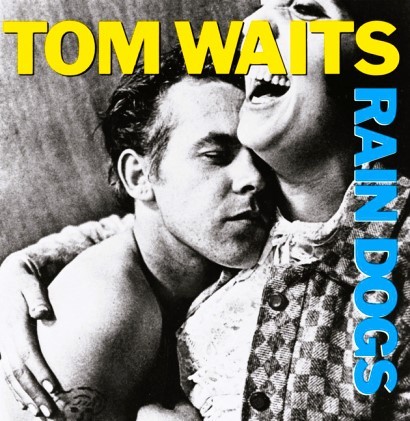
Tom Waits – Rain Dogs, Island Records, 1985, by Anders Petersen
Rain Dogs is the ninth studio album by American singer-songwriter Tom Waits, released in September 1985 on Island Records. A loose concept album about "the urban dispossessed" of New York City, Rain Dogs is generally considered the middle album of a trilogy that includes Swordfishtrombones and Franks Wild Years.
The album, which features guitarists Keith Richards and Marc Ribot, is noted for its broad spectrum of musical styles and genres, described by Arion Berger as merging "outsider influences – socialist decadence by way of Kurt Weill, pre-rock integrity from old dirty blues, the elegiac melancholy of New Orleans funeral brass – into a singularly idiosyncratic American style."
The album peaked at number 29 on the UK charts and number 188 on the US Billboard Top 200. Rod Stewart had success with his cover of "Downtown Train", later included on some editions of his 1991 album Vagabond Heart. In 1989, it was ranked number 21 on the Rolling Stone list of the "100 greatest albums of the 1980s." In 2012, the album was ranked number 399 on the magazine's list of "The 500 Greatest Albums of All Time", and at number 357 in 2020.
Though it has been remarked that the man on the cover bears a striking resemblance to Waits, the photograph is actually one of a series taken by the Swedish photographer Anders Petersen at Café Lehmitz (a café near the Hamburg red-light boulevard Reeperbahn) in the late 1960s. The man and woman depicted on the cover are called Rose and Lilly.
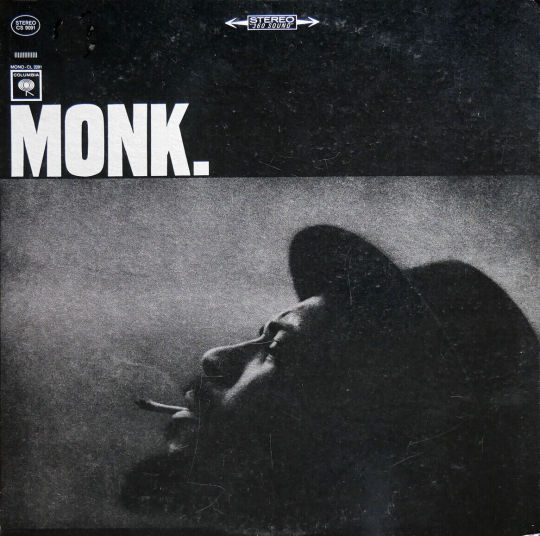
Thelonious Monk – Monk, Columbia, 1964, by W Eugene Smith
Monk. (1964) is the fourth studio album Thelonious Monk released on Columbia Records, and his seventh album overall for that label. It features two original compositions and several jazz standards.
The track "Pannonica" is a tribute to the jazz patron Pannonica de Koenigswarter. The track "Teo" is a tribute to the album's producer Teo Macero.
The album cover is a photo of Monk taken by W. Eugene Smith in 1959. Between 1957 and 1965, Monk and other prominent New York jazz musicians rehearsed at the photographer's home, nicknamed 'The Jazz Loft'.
Photographer and photojournalist W Eugene Smith demanded such perfection of his images that he destroyed most of his early work. He had a vast career and helped define photojournalism through his work at Life magazine, before joining Magnum Photos in 1955. He is remembered as a master both technically and in the darkroom. This photograph is titled Thelonious Monk Rehearsing in the Loft, 1959.
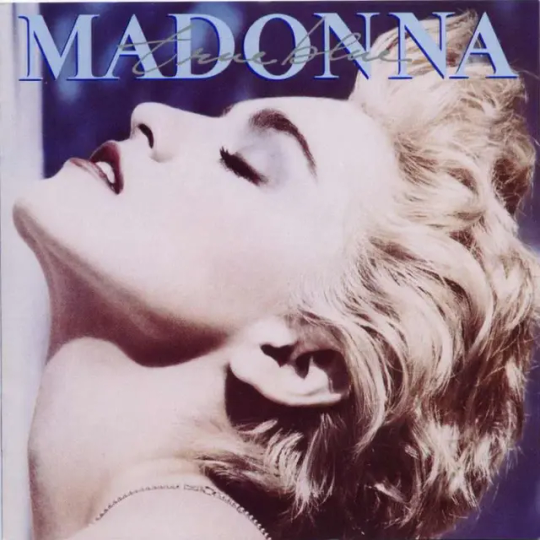
Madonna – True Blue, Sire/Warner, 1986, by Herb Ritts
The album cover was shot by photographer Herb Ritts. It shows Madonna in profile, with her head thrown back and eyes closed against a sky-blue background; her skin is bleached-out, and her hair platinum blonde. Jeri Heiden, who was working at the Warner Bros. art department, was given the task of editing the photos to adapt them into record covers. The final photo was selected by Madonna, Heiden and Jeff Ayeroff, creative director of Warner Bros. at that time. After the image was chosen, Heiden experimented with a variety of treatments of the original, which was shot in black and white, to go along with the album's title, and finally arrived at the final, blue toned, hand tinted version. The album's inner sleeve did not feature any photographs, and instead was dedicated to album credits and song lyrics, since Madonna wanted to be represented by her work rather than her image.
Lucy O'Brien described the cover as a "moment of Warholian pop art. A mixture of innocence [and] idealism […] Our first glimpse of Madonna as a classic icon". For J. Randy Taraborrelli, author of Madonna: An Intimate Biography, the artwork indicated how "[True Blue] was a vehicle of growth for [Madonna]"; the "washed out color photograph" cover was "understated", especially when compared to the "sexier poses" she had been associated with in the past. For Joe Lynch from Billboard, it is one of the greatest album covers of all time.
True Blue was released on June 30, 1986. In the United States and Canada, the cover did not include the singer's name. Heiden explained in an interview with Aperture magazine that the record company thought it would be "cool" to use a shrink wrap on American releases, so that when the public took it off, they'd be left with the photograph of Madonna. In Europe, Warner felt that the name was needed, as they did not want to risk messing with Madonna's popularity. The back sleeve and booklet feature the song titles in Heiden's own handwriting. About cropping the image for the cassette and vinyl releases, Heiden said: "I think the image became more interesting cropped into a square—and at that time we always started with the album cover configuration. It was like she was floating—her clothing was not visible. She took on the appearance of a marble statue—Goddess like. In the vertical cropping you see her leather jacket and the wall, and it becomes more typical, editorial, earthly". On May 22, 2001, Warner Bros. released a remastered edition of the album with two additional remixes of "True Blue" and "La Isla Bonita". Twenty years later, a 35th anniversary edition was released; it includes additional remixes, dub and instrumental versions. It was reissued on crystal clear vinyl on November 8, 2019.
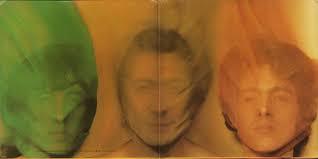
The Rolling Stones – Goats Heads Soup, The Rolling Stones Records, 1973, by David Bailey (design by Ray Lawrence)
Goats Head Soup is the eleventh studio album by the English rock band the Rolling Stones, released on 31 August 1973 by Rolling Stones Records. Like its predecessor Exile on Main St., the band composed and recorded much of it outside of the United Kingdom due to their status as tax exiles. Goats Head Soup was recorded in Jamaica, the United States and the United Kingdom. The album contains 10 tracks, including the lead single "Angie" which went to number one as a single in the US and the top five in the UK.
The album cover was designed by Ray Lawrence and photographed by David Bailey, a friend of Jagger's who had worked with the Rolling Stones since 1964. The portrait of Jagger on the front cover was approximately life size in the original 12-inch LP format. Jagger was reluctant to be shot enveloped by a pink chiffon veil, which Bailey said was meant to look like "Katharine Hepburn in The African Queen". The album's gatefold has Taylor, Wyman and Watts wrapped in a similar fabric, and Richards on the back. The album's original rejected cover art featured the entire band as centaurs and an image of goat's head soup, a Jamaican dish made from a goat's body parts, such as the head, feet and testicles.
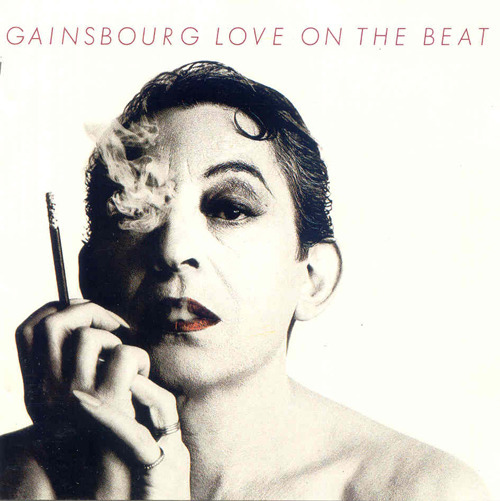
Serge Gainsbourg – Love on the Beat, Philips, 1984, by William Klein
Love on the Beat is the fifteenth studio album by French singer and songwriter Serge Gainsbourg. On this album, Gainsbourg used American musicians to achieve a funk-heavy rock sound. The album was controversial due to its very sexual lyrical content, with homosexuality and prostitution as the subject matters on many of the tracks. Perhaps the most controversial was "Lemon Incest", which was set to Frédéric Chopin's Étude No. 3 and sung as a duet with his then-13-year-old daughter Charlotte Gainsbourg.
French singer Serge Gainsbourg dressed in drag for the cover of Love on the Beat. Gainsbourg gave up alcohol for 12 days ahead of the shoot with legendary photographer William Klein to make himself beautiful.

Grace Jones – Island Life, Island Records, 1985, by Jean-Paul Goude (design by Greg Porto)
Island Life is the first greatest hits album by Jamaican singer and songwriter Grace Jones, released in December 1985, summing up the first nine years of her musical career. The album sits among Jones' best-selling works.
The cover picture is one of the most famous images of Grace Jones and was created by her then-partner Jean-Paul Goude. The impossibly graceful arabesque is actually a montage of separate images, following Goude's ideas on creating credible illusions with his cut-and-paint technique. The body position is "anatomically unlikely".
Jones assigned her then partner, Jean-Paul Goude, to create this cover image for Island Life. In what has become an iconic portrait, Goude compiled several separate snaps of Jones and constructed this lissom and elegant, if anatomically dubious, pose, all before Photoshop existed. ‘Unless you are extraordinarily supple, you cannot do this arabesque,’ Goude has said. ‘The main point is that Grace couldn’t do it, and that’s the basis of my entire work: creating a credible illusion’.
The picture was originally published in New York magazine in 1978 and subsequently used in the music video for Jones' hit single "La Vie en rose". It has been since described as "one of pop culture's most famous photographs". Also included in the album sleeve are other iconic images of Jones, among them the "twins" photograph, Grace Jones in a cage and wearing a "maternity" dress.
The cover picture was featured in Michael Ochs' 1996 book 1000 Record Covers and has been often imitated in works by other artists. The image was also referenced in Nicki Minaj's 2011 music video for "Stupid Hoe", with Minaj mimicking the pose.

Joe Jackson – Look Sharp!, A&M, 1979, by Brian Griffin (design by Michael Ross)
Look Sharp! is the debut album by Joe Jackson, released in January 1979. The album features one of Jackson's most well-known songs, "Is She Really Going Out with Him?", as well as the title track "Look Sharp", "Sunday Papers", "One More Time" and "Fools in Love".
The cover, featuring a pair of white shoes, ranked number 22 on Rolling Stone's list of the 100 greatest album covers of all time.
In 2000, it was voted number 865 in Colin Larkin's All Time Top 1000 Albums.
The photo used on the album's cover was shot by Brian Griffin on London's South Bank, near London Waterloo station. Upon arriving at the South Bank, Griffin noticed a shaft of light landing on the ground and asked Jackson to stand there: the whole process took no more than five minutes. According to Griffin, Jackson hated the record sleeve as it did not include his face, and vowed never to work with Griffin again. Nonetheless, the album artwork became one of the nominees for the 1980 Grammy Award for Best Recording Package.
Some observers didn't understand the tongue-in-cheek nature of Jackson's choice of title and cover art—an early reviewer in New Musical Express said they "suggest an obsession with style" and sniffed that Jackson sported "a pair of white side-lace Denson winklepickers that are, unfortunately, not nearly as cool as he evidently thinks they are". As time went on, journalists became more familiar with his youthful lack of interest in fashion, and The Face noted how most agreed with the general summation of him as a "sartorial disaster area".
Brian Griffin: ‘This was shot on London’s South Bank, which you could say was my open-air studio, as I did not have a studio then. I fell in love with the quality of light that pervaded there. It was the fastest album cover shoot that I ever did, maybe it took four minutes. I saw this patch of light making a pattern on the paving and said to Joe: “Stand there!”’

Diana Ross – Silk Electric, RCA, 1982, by Andy Warhol (photograph and design)
Silk Electric is the thirteenth studio album by American R&B singer Diana Ross, released on September 10, 1982, by RCA Records. It was Ross' second of six albums released by the label during the decade. It reached No. 27 on the US Billboard 200 (No. 5 R&B), No. 33 in the UK Albums Chart and the Top 20 in Sweden, Norway and the Netherlands. The album cover was designed by Andy Warhol.
The album contains Ross' US Top 10, Grammy-nominated single, "Muscles", which was written and produced by Michael Jackson. All other tracks were produced by Ross, including the US Top 40 follow-up single "So Close" featuring prominent background vocal arrangements by Luther Vandross.
The song "In Your Arms", written by Linda Creed and Michael Masser, was covered by Teddy Pendergrass and Whitney Houston as "Hold Me" the following year. The song "I Am Me" was co-written by Ross (and incorrectly listed as co-written by Cindy Birdsong instead of Janie Bradford on the Greatest Hits: The RCA Years compilation album). The album was certified Gold in the US and Silver in the UK.
The album was remastered and re-released on September 2, 2014 by Funky Town Grooves as an "Expanded Edition", with bonus material.
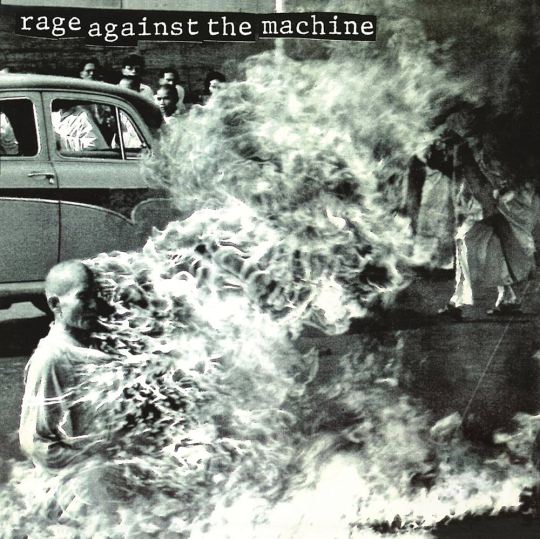
Rage Against the Machine – Rage Against the Machine, Epic, 1992, by Malcolm Browne
Rage Against the Machine is the debut studio album by American rock band Rage Against the Machine. It was released on November 6, 1992, by Epic Records, four days after the release of the album's first single, "Killing in the Name". The album was based largely on the band's first commercial demo tape of the same name, completed 11 months prior to the album's release. The tape contained earlier recordings of seven of the ten songs.
The cover features a crop of Malcolm Browne's famous photograph of the self-immolation of Thích Quảng Đức, a Vietnamese Buddhist monk, in Saigon in 1963. The monk was protesting against President Ngô Đình Diệm’s administration for oppressing the Buddhist religion. In 1963, Browne’s photography and coverage of the event earned him the World Press Photo of the Year award.
The songs on Rage Against the Machine all feature political messages. Activists such as Provisional IRA hunger striker Bobby Sands and Black Panther Party founder Huey P. Newton are listed in the "Thanks For Inspiration" section. Also thanked were Ian and Alec MacKaye.
The lyrics for each song were printed in the album booklet with the exception of those for "Killing in the Name", which were omitted; the booklet reads "2. KILLING IN THE NAME", skips the lyrics and continues with the next song.
The statement "no samples, keyboards or synthesizers used in the making of this record" can be found at the end of the sleeve notes. Similar statements were made in the band's subsequent albums. The band also refer to themselves as "Guilty Parties" for each album.
The album was a critical success upon release, with several critics noting the album's politically motivated agenda and praising frontman Zack de la Rocha's strong vocal delivery. Ranked number 24 on Rolling Stone's list of the "100 Greatest Metal Albums of All Time", the album peaked at number 1 on the US Billboard Heatseekers chart and number 45 on the US Billboard 200 and has gone on to achieve a triple platinum sales certification from the Recording Industry Association of America (RIAA) in the US. Multiple publications have ranked it as one of the best albums of the 1990s. In 2020, it was ranked 221 in Rolling Stone's updated list of the "500 Greatest Albums of All Time".

The Beatles – Abbey Road, Apple, 1969, by Iain Macmillan (design by John Kosh)
Abbey Road is the eleventh studio album by the English rock band the Beatles, released on 26 September 1969, by Apple Records. It is the last album the group recorded, although Let It Be (1970) was the last album completed before the band's break-up in April 1970. It was mostly recorded in April, July, and August 1969, and topped the record charts in both the United States and the United Kingdom. A double A-side single from the album, "Something" / "Come Together", was released in October, which also topped the charts in the US.
Apple Records creative director Kosh designed the album cover. It is the only original UK Beatles album sleeve to show neither the artist name nor the album title on its front cover, which was Kosh's idea, despite EMI saying the record would not sell without this information. He later explained that "we didn't need to write the band's name on the cover […] They were the most famous band in the world". The front cover was a photograph of the group walking on a zebra crossing, based on ideas that McCartney sketched, and taken on 8 August 1969 outside EMI Studios on Abbey Road. At 11:35 that morning, photographer Iain Macmillan was given only ten minutes to take the photo while he stood on a step-ladder and a policeman held up traffic behind the camera. Macmillan took six photographs, which McCartney examined with a magnifying glass before deciding which would be used on the album sleeve.
In the image selected by McCartney, the group walk across the street in single file from left to right, with Lennon leading, followed by Starr, McCartney and Harrison. McCartney is barefoot and out of step with the others. Except for Harrison, the group are wearing suits designed by Tommy Nutter. A white Volkswagen Beetle is to the left of the picture, parked next to the zebra crossing, which belonged to one of the people living in the block of flats across from the recording studio. After the album was released, the number plate (LMW 281F) was repeatedly stolen from the car. In 2004, news sources published a claim made by retired American salesman Paul Cole that he was the man standing on the pavement to the right of the picture.
Although Abbey Road was an instant commercial success, it received mixed reviews upon release. Some critics found its music inauthentic and criticised the production's artificial effects. By contrast, critics today view the album as one of the Beatles' best and one of the greatest albums of all time. George Harrison's two songs on the album, "Something" and "Here Comes the Sun", are considered among the best he wrote for the group. The album's cover, featuring the Beatles walking across the zebra crossing outside of Abbey Road Studios (then officially named EMI Studios), is one of the most famous and imitated of all time.

Graham Parker and the Rumour – The Parkerilla, Mercury, 1978, by Brian Griffin (design by Barney Bubbles)
The Parkerilla is a 1978 live double album by Graham Parker and The Rumour. It was recorded at Winter Gardens, Bournemouth, Manchester Opera House, Apollo Theatre, Oxford and The Palladium, New York City; and mixed at Rockfield Studios, Wales.
The album was recorded as a contractual obligation album as Parker had already signed with Arista and was preparing "Squeezing Out Sparks" for that label. The album was longer than a traditional record and Mercury elected to release it as a double album. The single "Hey Lord Don't Ask Me Questions" was a re-recording of a song from the first album (and slightly retitled) with the song occupying the fourth side.
The album met with a mixed reception from critics who were waiting for new material from Parker.
In 1991, Rolling Stone ranked The Parkerilla number 64 on its list of 100 greatest album covers. The cover photography was by Brian Griffin, with the artwork completed by Barney Bubbles.
Brian Griffin: ‘Dave Robinson of Stiff Records commissioned me for this. It was my first album cover and was shot on the South Bank in London next to the Hayward Gallery. The idea to make Graham Parker look like a gorilla was Dave’s, using prosthetics. This album was also my introduction to Barney Bubbles, who designed the cover’.

Led Zeppelin – Physical Grafitti, Swan Song, 1975, by Elliott Erwitt (design by AGI/Mike Doud/Peter Corriston)
Physical Graffiti is the sixth album by the English rock band Led Zeppelin. Released as a double album on 24 February 1975 in the United States and on 28 February 1975 in the United Kingdom, it was the group's first album to be released under their new label, Swan Song Records. The band wrote and recorded eight new songs for the album in early 1974 at Headley Grange, a country house in Hampshire, which gave them ample time to improvise arrangements and experiment with recording. The total playing time covered just under three sides of an LP, so they decided to expand it into a double album by including previously unreleased tracks from the sessions for the band's earlier albums Led Zeppelin III (1970), Led Zeppelin IV (1971) and Houses of the Holy (1973). The album covered a range of styles including hard rock, progressive rock, rock 'n' roll and folk. The album was then mixed over summer 1974 and planned for an end-of-year release; however, its release was delayed because the Peter Corriston-designed die-cut album cover proved difficult to manufacture.
The album was originally released with a die-cut sleeve design depicting a New York City tenement block, through whose windows various cultural icons could be interchangeably viewed. The album designer, Peter Corriston, was looking for a building that was symmetrical with interesting details, that was not obstructed by other objects and would fit the square album cover. He subsequently came up with the rest of the cover based on the idea of people moving in and out of the tenement, with various sleeves that could be placed under the main cover and filling the windows with various pieces of information.
The two five-storey buildings photographed for the album cover are located at 96 and 98 St. Mark's Place in New York City. The original photograph underwent a number of tweaks to arrive at the final image. The fourth floor of the building had to be cropped out to fit the square album cover format. (The front doorway and stoop at 96 St. Mark's Place is also the location used by the Rolling Stones for the music video promoting their single "Waiting on a Friend", from their 1981 album Tattoo You).
Eschewing the usual gatefold design in favour of a special die-cut cover, the original album jacket included four covers made up of two inners (for each disc), a middle insert cover and an outer cover. The middle insert cover is white and details all the album track listings and recording information. The outer cover has die-cut windows on the building, so when the middle cover is wrapped around the inner covers and slid into the outer cover, the title of the album is shown on the front cover, spelling out the name "Physical Graffiti". Images in the windows touched upon a set of American icons and a range of Hollywood ephemera. Pictures of W. C. Fields and Buzz Aldrin alternated with the snapshots of Led Zeppelin. Photographs of Lee Harvey Oswald, Marcel Duchamp and Pope Leo XIII are also featured. Per the liner notes, package concept and design was by AGI/Mike Doud (London) and Peter Corriston (New York). Photography was by Elliott Erwitt, B. P. Fallon, and Roy Harper. "Tinting Extraordinaire": Maurice Tate, and window illustration by Dave Heffernan. In 1976, the album was nominated for a Grammy Award in the category of best album package.
Physical Graffiti was commercially and critically successful upon its release and debuted at number one on album charts in the UK and number three in the United States. It was promoted by a successful U.S. tour and a five-night residency at Earl's Court, London. The album has been reissued on CD several times, including an expansive 40th anniversary edition in 2015. Physical Graffiti was later certified 16× platinum in the United States by the Recording Industry Association of America (RIAA) in 2006, signifying shipments of over eight million copies in the US.
Daily inspiration. Discover more photos at Just for Books…?
#just for books#Best Album Cover Shoots#Grace Jones#Prince#Boz Scaggs#Tirez Tirez#Tom Waits#Thelonious Monk#Madonna#The Rolling Stones#Serge Gainsbourg#Joe Jackson#Diana Ross#Rage Against the Machine#The Beatles#Graham Parker and the Rumour#Led Zeppelin
20 notes
·
View notes
Text
Opera on YouTube, Part 2
Le Nozze di Figaro (The Marriage of Figaro)
Glyndebourne Festival Opera, 1973 (Knut Skram, Ileana Cotrubas, Kiri Te Kanawa, Benjamin Luxon; conducted by John Pritchard; English subtitles)
Jean-Pierre Ponnelle studio film, 1976 (Hermann Prey, Mirella Freni, Kiri Te Kanawa, Dietrich Fischer-Dieskau; conducted by Karl Böhm; English subtitles) – Acts I and II, Acts III and IV
Tokyo National Theatre, 1980 (Hermann Prey, Lucia Popp, Gundula Janowitz, Bernd Weikl; conducted by Karl Böhm; Japanese subtitles)
Théâtre du Châtelet, 1993 (Bryn Terfel, Alison Hagley, Hillevi Martinpelto, Rodney Gilfry; conducted by John Eliot Gardiner; Italian subtitles)
Glyndebourne Festival Opera, 1994 (Gerald Finley, Alison Hagley, Renée Fleming, Andreas Schmidt; conducted by Bernard Haitink; English subtitles)
Zürich Opera House, 1996 (Carlos Chaussón, Isabel Rey, Eva Mei, Rodney Gilfry; conducted by Nikolaus Harnoncourt; English subtitles)
Berlin State Opera, 2005 (Lauri Vasar, Anna Prohaska, Dorothea Röschmann, Ildebrando d'Arcangelo; conducted by Gustavo Dudamel; French subtitles)
Salzburg Festival, 2006 (Ildebrando d'Arcangelo, Anna Netrebko, Dorothea Röschmann, Bo Skovhus; conducted by Nikolas Harnoncourt; English subtitles) – Acts I and II, Acts III and IV
Teatro all Scala, 2006 (Ildebrando d'Arcangelo, Diana Damrau, Marcella Orasatti Talamanca, Pietro Spagnoli; conducted by Gérard Korsten; English and Italian subtitles)
Salzburg Festival, 2015 (Adam Plachetka, Martina Janková, Anett Fritsch, Luca Pisaroni; conducted by Dan Ettinger; no subtitles)
Tosca
Carmine Gallone studio film, 1956 (Franca Duval dubbed by Maria Caniglia, Franco Corelli, Afro Poli dubbed by Giangiacomo Guelfi; conducted by Oliviero de Fabritiis; no subtitles)
Gianfranco de Bosio film, 1976 (Raina Kabaivanska, Plácido Domingo, Sherrill Milnes; conducted by Bruno Bartoletti; English subtitles)
Metropolitan Opera, 1978 (Shirley Verrett, Luciano Pavarotti, Cornell MacNeil; conducted by James Conlon; no subtitles)
Arena di Verona, 1984 (Eva Marton, Jaume Aragall, Ingvar Wixell; conducted by Daniel Oren; no subtitles)
Teatro Real de Madrid, 2004 (Daniela Dessí, Fabio Armiliato, Ruggero Raimondi; conducted by Maurizio Benini; English subtitles)
Royal Opera House, Covent Garden, 2011 (Angela Gheorghiu, Jonas Kaufmann, Bryn Terfel; conducted by Antonio Pappano; English subtitles)
Finnish National Opera, 2018 (Ausrinė Stundytė, Andrea Carè, Tuomas Pursio; conducted by Patrick Fournillier; English subtitles)
Teatro alla Scala 2019 (Anna Netrebko, Francesco Meli, Luca Salsi; conducted by Riccardo Chailly; Hungarian subtitles)
Vienna State Opera, 2019 (Sondra Radvanovsky, Piotr Beczala, Thomas Hampson; conducted by Marco Armiliato; English subtitles)
Ópera de las Palmas, 2024 (Erika Grimaldi, Piotr Beczala, George Gagnidze; conducted by Ramón Tebar; no subtitles)
Don Giovanni
Salzburg Festival, 1954 (Cesare Siepi, Otto Edelmann, Elisabeth Grümmer, Lisa della Casa; conducted by Wilhelm Furtwängler; English subtitles)
Giacomo Vaccari studio film, 1960 (Mario Petri, Sesto Bruscantini, Teresa Stich-Randall, Leyla Gencer; conducted by Francesco Molinari-Pradelli; no subtitles)
Salzburg Festival, 1987 (Samuel Ramey, Ferruccio Furlanetto, Anna Tomowa-Sintow, Julia Varady; conducted by Herbert von Karajan; no subtitles)
Teatro alla Scala, 1987 (Thomas Allen, Claudio Desderi, Edita Gruberova, Ann Murray; conducted by Riccardo Muti; English subtitles)
Peter Sellars studio film, 1990 (Eugene Perry, Herbert Perry, Dominique Labelle, Lorraine Hunt Lieberson; conducted by Craig Smith; English subtitles)
Teatro Comunale di Ferrara, 1997 (Simon Keenlyside, Bryn Terfel, Carmela Remigio, Anna Caterina Antonacci; conducted by Claudio Abbado; no subtitles) – Act I, Act II
Zürich Opera, 2000 (Rodney Gilfry, László Polgár, Isabel Rey, Cecilia Bartoli; conducted by Nikolaus Harnoncourt; English subtitles)
Festival Aix-en-Provence, 2002 (Peter Mattei, Gilles Cachemaille, Alexandra Deshorties, Mirielle Delunsch; conducted by Daniel Harding; no subtitles)
Teatro Real de Madrid, 2006 (Carlos Álvarez, Lorenzo Regazzo, Maria Bayo, Sonia Ganassi; conducted by Victor Pablo Pérez; English subtitles)
Festival Aix-en-Provence, 2017 (Philippe Sly, Nahuel de Pierro, Eleonora Burratto, Isabel Leonard; conducted by Jérémie Rohrer; English subtitles)
Madama Butterfly
Mario Lanfranchi studio film, 1956 (Anna Moffo, Renato Cioni; conducted by Oliviero de Fabritiis; no subtitles)
Jean-Pierre Ponnelle studio film, 1974 (Mirella Freni, Plácido Domingo; conducted by Herbert von Karajan; English subtitles)
New York City Opera, 1982 (Judith Haddon, Jerry Hadley; conducted by Christopher Keene; English subtitles)
Frédéric Mitterand film, 1995 (Ying Huang, Richard Troxell; conducted by James Conlon; English subtitles)
Arena di Verona, 2004 (Fiorenza Cedolins, Marcello Giordani; conducted by Daniel Oren; Spanish subtitles)
Sferisterio Opera Festival, 2009 (Raffaela Angeletti, Massimiliano Pisapia; conducted by Daniele Callegari; no subtitles)
Vienna State Opera, 2017 (Maria José Siri, Murat Karahan; conducted by Jonathan Darlington; no subtitles)
Wichita Grand Opera, 2017 (Yunnie Park, Kirk Dougherty; conducted by Martin Mazik; English subtitles)
Teatro San Carlo, 2019 (Evgenia Muraveva, Saimir Pirgu; conducted by Gabriele Ferro; no subtitles)
Rennes Opera House, 2022 (Karah Son, Angelo Villari; conducted by Rudolf Piehlmayer; French subtitles)
#opera#complete performances#youtube#le nozze di figaro#the marriage of figaro#tosca#don giovanni#madama butterfly#madame butterfly#wolfgang amadeus mozart#giacomo puccini
93 notes
·
View notes
Text
Okay, folks, the mini-tourney is inching closer to the finals, so I'm going to give a list of the competitors in the Miss Billboard Tourney in order to give everyone a chance to submit more propaganda. The nominees are:
Lale Andersen
Marian Anderson
Signe Toly Anderson
Julie Andrews
LaVerne Andrews
Maxene Andrews
Patty Andrews
Ann-Margret
Joan Armatrading
Dorothy Ashby
Joan Baez
Pearl Bailey
Belle Baker
Josephine Baker
LaVern Baker
Florence Ballard
Brigitte Bardot
Eileen Barton
Fontella Bass
Shirley Bassey
Maggie Bell
Lola Beltran
Ivy Benson
Gladys Bentley
Jane Birkin
Cilla Black
Ronee Blakley
Teresa Brewer
Anne Briggs
Ruth Brown
Joyce Bryant
Vashti Bunyan
Kate Bush
Montserrat Caballe
Maria Callas
Blanche Calloway
Wendy Carlos
Cathy Carr
Raffaella Carra
Diahann Carroll
Karen Carpenter
June Carter Cash
Charo
Cher
Meg Christian
Gigliola Cinquetti
Petula Clark
Merry Clayton
Patsy Cline
Rosemary Clooney
Natalie Cole
Judy Collins
Alice Coltrane
Betty Comden
Barbara Cook
Rita Coolidge
Gal Costa
Ida Cox
Karen Dalton
Marie-Louise Damien
Betty Davis
Jinx Dawson
Doris Day
Blossom Dearie
Kiki Dee
Lucienne Delyle
Sandy Denny
Jackie DeShannon
Gwen Dickey
Marlene Dietrich
Marie-France Dufour
Julie Driscoll
Yvonne Elliman
Cass Elliot
Maureen Evans
Agnetha Faeltskog
Marianne Faithfull
Mimi Farina
Max Feldman
Gracie Fields
Ella Fitzgerald
Roberta Flack
Lita Ford
Connie Francis
Aretha Franklin
France Gall
Judy Garland
Crystal Gayle
Gloria Gaynor
Bobbie Gentry
Astrud Gilberto
Donna Jean Godchaux
Lesley Gore
Eydie Gorme
Margo Guryan
Sheila Guyse
Nina Hagen
Francoise Hardy
Emmylou Harris
Debbie Harry
Annie Haslam
Billie Holiday
Mary Hopkin
Lena Horne
Helen Humes
Betty Hutton
Janis Ian
Mahalia Jackson
Wanda Jackson
Etta James
Joan Jett
Bessie Jones
Etta Jones
Gloria Jones
Grace Jones
Shirley Jones
Tamiko Jones
Janis Joplin
Barbara Keith
Carole King
Eartha Kitt
Chaka Khan
Hildegard Knef
Gladys Knight
Sonja Kristina
Patti Labelle
Cleo Laine
Nicolette Larson
Daliah Lavi
Vicky Leandros
Peggy Lee
Rita Lee
Alis Lesley
Barbara Lewis
Abbey Lincoln
Melba Liston
Julie London
Darlene Love
Lulu
Anni-Frid Lyngstad
Barbara Lynn
Loretta Lynn
Vera Lynn
Siw Malmkvist
Lata Mangeshkar
Linda McCartney
Kate McGarrigle
Christie McVie
Bette Midler
Jean Millington
June Millington
Liza Minnelli
Carmen Miranda
Joni Mitchell
Liz Mitchell
Marion Montgomery
Lee Morse
Nana Mouskouri
Anne Murray
Wenche Myhre
Holly Near
Olivia Newton-John
Stevie Nicks
Nico
Laura Nyro
Virginia O’Brien
Odetta
Yoko Ono
Shirley Owens
Patti Page
Dolly Parton
Freda Payne
Michelle Phillips
Edith Piaf
Ruth Pointer
Leontyne Price
Suzi Quatro
Gertrude Rainey
Bonnie Raitt
Carline Ray
Helen Reddy
Della Reese
Martha Reeves
June Richmond
Jeannie C. Riley
Minnie Riperton
Jean Ritchie
Chita Rivera
Clara Rockmore
Linda Ronstadt
Marianne Rosenberg
Diana Ross
Anna Russell
Melanie Safka
Buffy Sainte-Marie
Samantha Sang
Pattie Santos
Hazel Scott
Doreen Shaffer
Jackie Shane
Marlena Shaw
Sandie Shaw
Dinah Shore
Judee Sill
Carly Simon
Nina Simone
Nancy Sinatra
Siouxsie Sioux
Grace Slick
Bessie Smith
Mamie Smith
Patti Smith
Ethel Smyth
Mercedes Sosa
Ronnie Spector
Dusty Springfield
Mavis Staples
Candi Staton
Barbra Streisand
Poly Styrene
Maxine Sullivan
Donna Summer
Pat Suzuki
Norma Tanega
Tammi Terrell
Sister Rosetta Tharpe
Big Mama Thornton
Mary Travers
Moe Tucker
Tina Turner
Twiggy
Bonnie Tyler
Sylvia Tyson
Sarah Vaughan
Sylvie Vartan
Mariska Veres
Akiko Wada
Claire Waldoff
Jennifer Warnes
Dee Dee Warwick
Dionne Warwick
Dinah Washington
Ethel Waters
Elisabeth Welch
Kitty Wells
Mary Wells
Juliane Werding
Tina Weymouth
Cris Williamson
Ann Wilson
Mary Wilson
Nancy Wilson
Anna Mae Winburn
Syreeta Wright
Tammy Wynette
Nan Wynn
Those in italics have five or more pieces of usable visual, written, or audio propaganda already. If you have any visuals like photos or videos, or if you have something to say in words, submit it to this blog before round one begins on June 25th!
If you don't see a name you submitted here, it's because most or all of their career was as a child/they were too young for the cutoff, their career was almost entirely after 1979, or music was something they only dabbled in and are hardly known for. There are quite a few ladies on the list whose primary career wasn't "recording artist" or "live musician," but released several albums or were in musical theater, so they've been accepted.
#long post#miss billboard tourney#i wasn't originally going to list them all but i decided to do so because there are so many without propaganda
48 notes
·
View notes
Text


Masque à gaz Mickey Mouse - 1940's
©US Army Chemical Museum
Le 7 janvier 1942, un mois après l'attaque des japonais sur Pearl Harbor, Le propriétaire de la société Sun Rubber Company T.W. Smith Jr et son assistant Dietrich Rempel, présentent un modèle de masque à gaz 'Mickey Mouse' au Major Général William N. Porter Chef du service de la guerre chimique. Le masque destiné aux enfants sera fabriqué sous licence Walt Disney. Le design définitif du masque sera réalisé par Walt Disney.
#WWII#ww2#home front#défense passive#passive defence#masque à gaz#gaz mask#mickey mouse#walt disney#états-unis#usa#1940's
11 notes
·
View notes
Text
Good Omens Aziraphale's Sad Bastard Breakup Playlist
After the breakup, Aziraphale has a new job in heaven, having taken Gabriel’s vacant position. Aziraphale is haunted by sad music reminding him of his time with Crowley. The songs are dramatic, tragic, melancholic, angry, wistful, romantic, and sentimental. How does he listen to music at his new job in the head office? Are material objects allowed? Does he keep a secret stash of tea, cake, and records and a phonograph player in his office? Does he have a celestial radio that can tune in Earth radio stations? Does he sneak off to Earth to hang out in record shops and bookstores? Or more dramatically and emotionally torturously, does he remember every note, every nuance, every feeling, of every song and replay them in his mind? He's stuffing his face with angel food cake and tea while crying and listening to sad bastard songs and hiding from Michael and the Metatron.
See note after list on song selection process.
Songs include:
“Lacrimosa” – Mozart, Requiem in D Minor, Vienna Mozart Orchestra
“Commendatore” – Mozart, Don Giovanni, Amadeus film soundtrack
“Ja, tot katoramu vnimala” – Rubenstein, The Demon, Nicolai Ghiaurov
“D’amour l’ardente flemme” – Berlioz, The Damnation of Faust, Maria Callas
“Liebestod” – Wagner, Tristan and Isolde, Waltraud Meier
“Ach ich fuhls” – Mozart, The Magic Flute, Gundula Janowitz
“Thy hand, Belinda … When I am laid in earth” – Purcell, Dido and Aeneas, Janet Baker
“E lucevan la stelle” – Puccini, Tosca, Placido Domingo
“Celeste Aidia” – Verdi, Aida, Mario Lanza
“Ich bin der Welt abhanden gekommen” Mahler, Dietrich Fischer-Dieskau
“Der Wanderer” – Schubert, Dietrich Fischer-Dieskau
“Love is a Plaintive Song” – Gilbert and Sullivan, Patience, D’Oyly Carte Opera Company
“I am a Courtier Grave and Serious” – Gilbert and Sullivan, The Gondoliers, D’Oyly Carte Opera Company
“The Gentleman is a Dope” – Rodgers and Hammerstein, Allegro, Blossom Dearie
“A Hymn to Him” – Lerner and Lowe, My Fair Lady, Rex Harrison
“Could I Leave You?” – Sondheim, Follies, Alexis Smith
“We Do Not Belong Together” – Sondheim, Sunday in the Park with George, Bernadette Peters and Mandy Patinkin
“On My Own” – Schonberg, Les Misérables, Frances Ruffelle
“As Long as He Needs Me” – Bert, Oliver, Judy Garland
“Stranger in Paradise” – Wright and Forest, Kismet, Richard Kiley and Doretta Morrow
“A Nightingale Sang in Berkeley Square” – Sherwin and Maschwitz, Vera Lynn
“Night and Day” – Porter, The Gay Divorcee, Ella Fitzgerald
“I’ve Got You Under My Skin” – Porter, Born to Dance, Shirley Bassey
“Bewitched, Bothered, and Bewildered” – Rodgers and Heart, Pal Joey, Sarah Vaughan
“They Can’t Take That Away From Me” – Gershwin, Shall We Dance, Fred Astaire
“Mon Deu” – Dumont and Vaucaire, Edith Piaf
“Non, Je Ne Regrette Rien” – Dumont and Vaucaire, Edith Piaf
P.S.: Aziraphale likes Les Mis because it reminds him of that time Crowley rescued him from the Bastille. Don't tell anyone. It's a big secret.
P.P.S.: “Bewitched, Bothered, and Bewildered” reminds him of the time he and Crowley got drunk in the backroom at the bookshop the day the anti-Christ was delivered to Earth. Basically, this song reminds him of every time they went out for drinks or stayed in and drank.
P.P.P.S.: “I am a Courtier Grave and Serious” was the song Aziraphale planned to play when trying to tempt Crowley into learning the gavotte. It reminds him of the ball in the bookstore when he finally danced with Crowley.
P.P.P.P.S.: “Non, Je Ne Regrette Rien” is as close as Aziraphale can get to telling the world and Crowley to eff off. He has no more effs to give. Or at least he’s trying to convince himself he no longer gives a f***. He’s going off to his new job at the head office and Do Good.
Note on song selection:
I selected songs that thematically fit with the relationship between Aziraphale and Crowley. I think the songs tell a story of Aziraphale’s struggle to reconcile his conflicted motivations. They reflect Aziraphale’s fears and desires. He fears being hauled off to hell for disobedience. He fears Crowley’s death and being alone in the world. He desires to be emotionally intimate with Crowley. (Dare he risk physical intimacy with Crowley?) He feels self-righteously indignant, but he’s soft and squishy and weepy and misses his best friend.
I don’t have much knowledge of opera or musical theater, but I have some experience with choir and solo performance. I did a lot of research into opera, art songs, musicals, showtunes, and standards to create a playlist on YouTube. Selections were based on availability, popularity, and sound quality. My big question was whether or not Aziraphale is a strict originalist or if he likes different versions of songs. In some places, I chose newer versions over original versions due to the sound quality of the recordings. I tried to keep selections accessible to a wide audience with varying degrees of musical knowledge. You may not like my choices, so your mileage may vary. You can make your own playlist.
You can listen to it on YouTube.
#good omens 2#neil gaiman#aziraphale#crowley#breakup#sad bastard music#angry love songs#breakup playlist#playlist
25 notes
·
View notes
